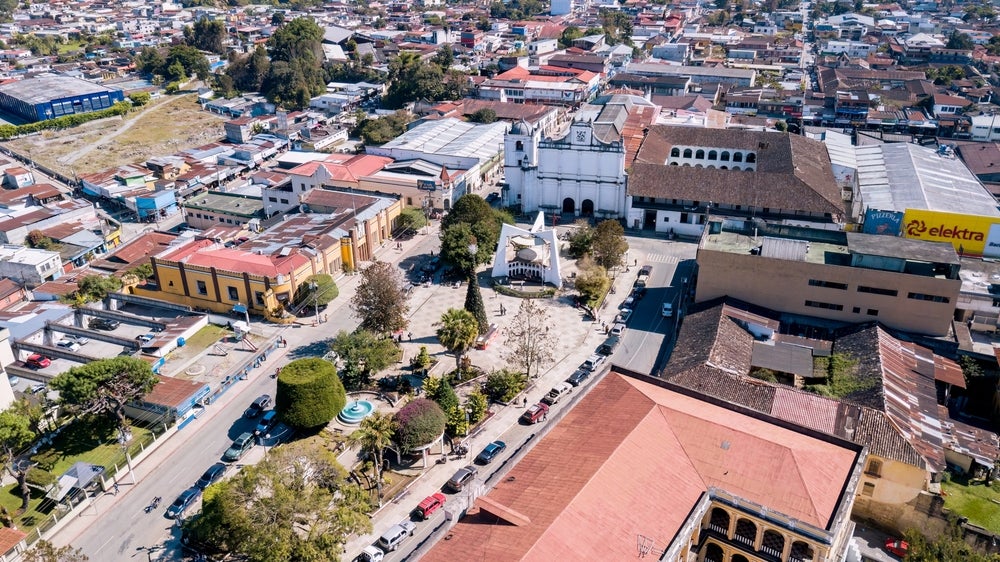American Apparel & Footwear Association's senior director of sustainability Chelsea Murtha has heard apparel suppliers' complain about over-subscripted sustainability requirements from fashion brands so she was "heartened" to discover that Guatemala's apparel suppliers are not waiting for fashion brands to tell them what to do.
Murtha, along with AAFA vice president of trade and customs policy Beth Hughes and University of Delaware's professor of apparel studies Dr Sheng Lu were invited to attend Guatemala's apparel sourcing show and visit multiple textile apparel manufacturing facilities.
During an exclusive chat with Just Style after the event Murtha explains: "I was asked to speak along with Sheng at a forum they were holding at the show and most of the panels had a significant sustainability aspect."
She continues: "It was interesting to see how many people were in the room – suppliers were there and paying attention and several members of the Guatemalan government were also asking lots of questions."
For Dr Lu, the two main takeaways from the trip were Guatemala's excitement to expand its textile and apparel offering and continue to attract new investments and the fact that most of the products it produces will serve the local and regional market.
Benefits of Guatemala's nearsourcing and regional supply chain
The country understands that nearsourcing is an obvious way to improve sustainability within its fashion supply chain with Lu highlighting: "If you speak to Asian suppliers their ambition is the world market whereas Guatemala is specifically interested in the US and its fellow CAFTA-DR members."
From an investment point of view, Hughes notes that despite the US being a target market, it's investments are not necessarily coming from the US. Instead, it is receiving capital from countries the US has good relationships with.
She also shares Guatemala is "killing it" on cotton products and it benefits from "the speed to market, proximity and free trade agreements" it has with the US.
However, she admits fashion brands are still asking for more investments in yarns and fabrics which means some suppliers have to bring the yarn and fabric in from Asia.
"We’d see a real boom if it had more investments in technical [materials] as [brands] would like to see the spandex's that go into leggings and jeans and athleisure," she explains.
What's frustrating for Hughes is there is a disconnect between US administration and congress policies based around a "get out of China rhetoric" and the fact the US isn't taking more advantage of its "backyard " and the agreements that are already in place for countries such as Guatemala.
She reveals: "It’s going to be a slower process unless it becomes seen as the power player it could be."
On the plus side, Lu is "very impressed" by the number of textile mills at the show as traditionally he says CAFTA-DR is regarded as a leading apparel exporting country or destination for finished garments
He continues: "Textiles is considered a bottle neck to make more kinds of products. but we saw a presence of textile mills with local manufacturers eager to expand their textile manufacturing capabilities. We also saw wovens and a strong interest to expand manufacturing in the region."
It is widely understood that Guatemala uses US-made textiles, however when Lu spoke to the local factories they explained they are using locally made textiles. It’s not fabrics made from Guatemala per se, but they import them from neighbouring countries El Salvador and Honduras with Lu adding: "We can see the endurance of the regional supply chain."
Lu points out the statistics support this with a fifth of yarn in textile raw materials being locally made by CAFTA-DR and he expects this percentage to increase.
Recycled material opportunity for Guatemala
One of the messages Murtha was keen to bring to Guatemala during her sustainability talk was the huge potential of recycled materials.
She explains: "We’re expecting to see change in materials and origin as we look more at textile-to-textile recycling. This could create an interesting opportunity as if we assume the collecting is done in the US it means it's a US origin fabric so maybe there’s a chance to get some of these fabrics into the region?"
She goes as far as to say Central America as a whole could play a "big role" in the US' shift to recycled textiles.
"Textile recycling would open a whole new industry and a lot of new jobs. It could be cupcakes and rainbows if they take the opportunity and if we as the US have the policies in place to incentivise and support them," she asserts.
Murtha is quick to admit this is a long-term vision but it could set the country up for future success.
Her advice is for apparel suppliers to speak to emerging textile recycling technology companies as the rules aren’t written yet about how materials are going to flow but, she states that alongside Extended Producer Responsibility (EPR), everyone is trying to reduce their emissions so this would make sense for brands from an emissions standpoint.
She believes there is potential for textile technology companies to invest in Guatemala as the US circular economy will create US jobs, it will also be vital to get trade partners such as Guatemala involved.
She adds: "We're definitely trying to encourage those conversations but it's maybe a little early in terms of technology companies."
Of the four apparel and textile manufacturing facilities the trio visited during their trip, Lu points out some of them are already starting to demonstrate a "strong interest" in recycled materials.
He adds his "overall impression is a textile and apparel industry that is on the growth trajectory with a confident market outlook".
How can Guatemala grow its sustainable material offering?
For Hughes, the key question remains: How to expand Guatemala's offering to give fashion brands the items they would really like.
In future, recycled materials could be part of this solution but today the problem remains that lifestyle brands carry lots of different kinds of products so if Guatemala wants to place more orders it will need to diversify its offering.
Murtha agrees and also points to Guatemala's use of US cotton being "limiting" in some respects, however it does give the country the advantage of being able to give fashion brands complete traceability.
Even with these concerns, Lu maintains fashion brands see Guatemala as an attractive sourcing partner given its lower compliance risk overall. He says its new manufacturing facilities and overall large capacity can meet regulations better than some of those found in Asia.
Is Guatemala's government supporting wider sustainability plan?
Apparel suppliers expressed to Murtha during the event they feel Guatemala's energy policy needs to support their sustainability transition towards electrification.
She was told it’s not yet possible to sell energy back to the grid, which would make it easier for manufacturers to make a case for a return on investment.
Murtha remains optimistic that an energy policy could be put in place but explains Guatemala has a relatively new government following its general election in June last year.
But, she shares the deputy minister for climate change and the wider government were present at the event and showed an interest in supporting and hearing from the industry.
How can Guatemala take its sustainable apparel sourcing forward?
For Lu, Guatemala's new government is in a very strong position as it will benefit from CAFTA-DR, which is a permanent trade agreement. He hopes fashion brands and apparel companies as well as apparel suppliers and textile mills will take advantage of the benefits to make more investments in the country and build a more integrated regional supply chain and invite more brands and retailers to visit its factories.
He urges the country to focus on fashion education as he believes this is lacking at the moment but fostering new talent will be essential for expanding its capabilities, especially within textiles and sustainability.
He notes: "For textile engineering in particular, the industry needs to understand the textile manufacturing process."
Hughes urges fashion brands and apparel suppliers to continue conversations. She says: "Some brands are really trying to be good stewards of the industry and make sure their suppliers are as well and those relationships are strong."
Attracting new brands to the region is also important and she explains the AAFA has been working on getting the right people in the room so this will continue to grow.
Murtha highlights the importance of certifications, particularly for sustainability. She's adamant that consistency will make it easier for all actors within the supply chain but before this becomes the norm, it could allow Guatemala to stand out from its competitors.
Lu agrees and points out that majority of the factories he visited in the country have impressive research and development (R&D) capabilities and are meeting new regulations.
He suggests Guatemala apparel factories should invite sourcing managers to see what's happening first-hand in the region and encourage a Guatemala study abroad tour for fashion sourcing students as these are fashion brands' "future sourcing managers".
Guatemala is already one step ahead in the sense that it understands deeper collaborations and partnerships are key to its future sustainable apparel sourcing success as well as fulfilling certification requirements.
If anything, Murtha clarifies: "Standardisation was the key message they wanted to get across and I think brands are on the same page and it's really more about trying to ensure regulators understand what they are creating and how the systems will work together."
Lu concludes there's a bright future for Guatemala to play a more significant role in US apparel sourcing and sustainability and he sees "great potential for the region as a whole to become a consumption market for finished garments".









